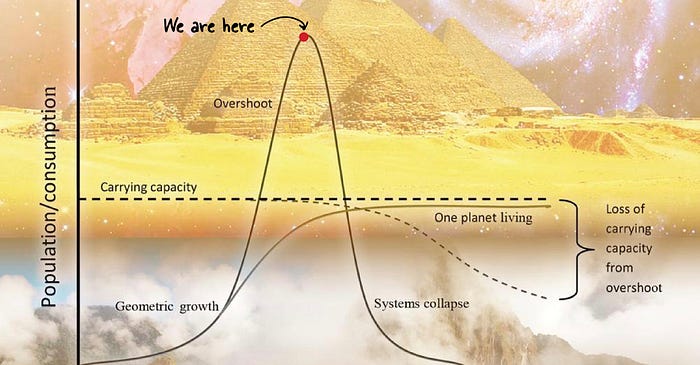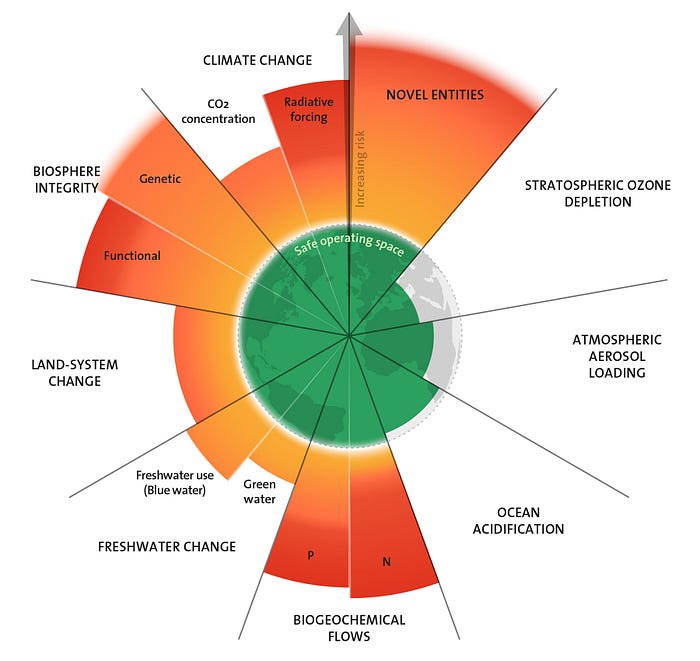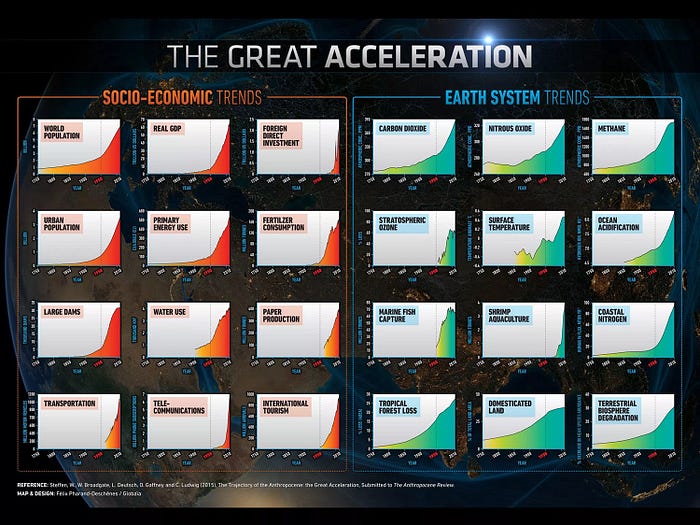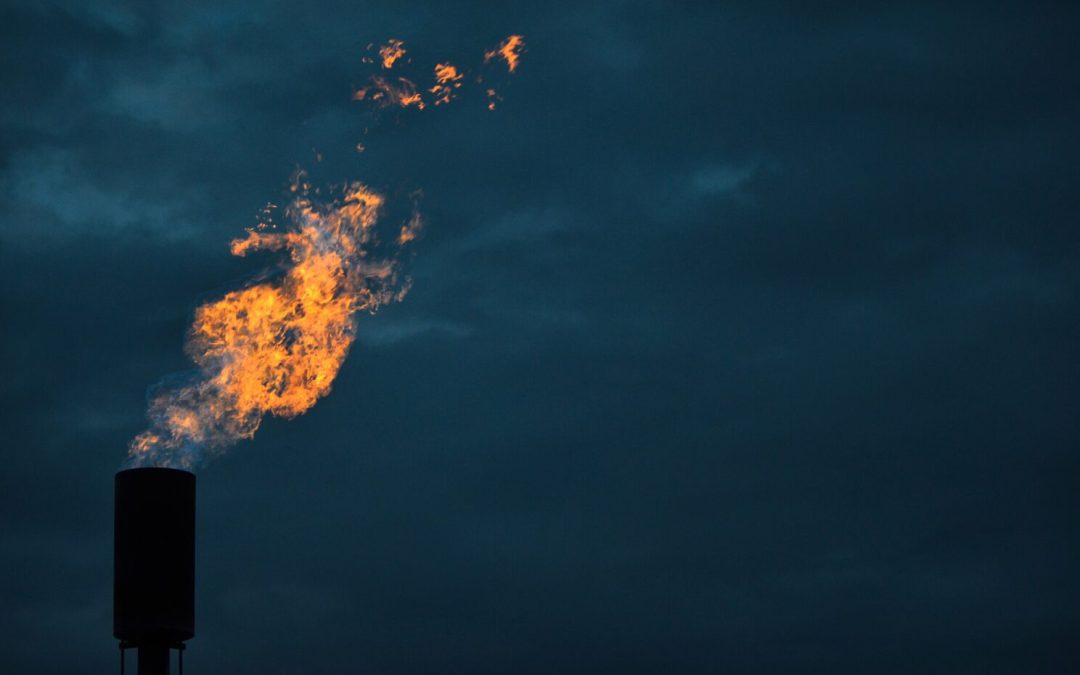
by DGR News Service | Nov 8, 2024 | ANALYSIS, The Problem: Civilization
Editor’s notes: Methane(CH4) is the main component of natural gas. The word comes from the Greek methy “wine” + hylē “wood.” However, marketers came up with the term natural gas rather than methane gas to give it a clean, green image. Methane is produced by decaying organic material. Natural sources, such as wetlands, account for roughly 40% of today’s global methane emissions. But the majority comes from human activities, such as farms, landfills, dams and wastewater treatment plants – and fuel production. Oil, gas, and coal together make up about a third of global methane emissions. It can leak anywhere along the supply chain, from the wellhead and processing plant, through pipelines and distribution lines, all the way to the burner of your home’s stove or furnace. Once it reaches the atmosphere, methane’s super heat-trapping properties render it a major agent of warming. Over the last 20 years, methane has caused 85 times more warming than the same amount of carbon dioxide. But methane doesn’t stay in the atmosphere for long. Unlike carbon dioxide, which lingers in the atmosphere for a century or more, methane only sticks around for about a dozen years.
Unlit or inefficient flares are another big source. Some companies routinely burn off excess gas that they can’t easily capture or don’t have the pipeline capacity to transport, but that still releases methane and carbon dioxide into the atmosphere. Global oil and gas operations emitted more methane in 2021 than Canada consumed that entire year, according to IEA estimates.
The only way to keep wetlands carbon in the ground is to quickly reduce and ultimately eliminate greenhouse gas emissions from human activities. Failing to do so will only give global warming a helping hand – as warming thaws wetlands and releases more methane, carbon and nitrogen from ancient stores, thus creating a continuous positive feedback loop. In total, methane is responsible for almost half of the global temperature rises since the industrial era.
The rapid growth in the atmospheric methane burden that began in late 2006 is very different from methane’s past observational record. Atmospheric methane’s unprecedented current growth is similar to ice core methane records during glacial-interglacial “termination” events marking global reorganizations of the planetary climate system.
Civilization, being what it is, cannot stop itself from using technology to mitigate the consequences of technological uses. Since civilization can not, on its own, take the necessary steps to relieve its addiction to modernity, it doubles down with solar panels and wind turbines. They are now looking at ways to geoengineer methane emissions. All in a doomed attempt to find a false solution to an overshoot predicament. This system can not continue, and it will be an outside force that brings it down. When that happens it would be best to have as much of the natural world left as possible.
By Olivia Rosane staff writer for Common Dreams
The number of methane “super-emitters” detected by a satellite company has surged by approximately one-third over the past year, despite pledges from fossil fuel companies to reduce their emissions of the highly potent greenhouse gas.
Stephane Germain, the CEO of methane-tracking company GHGSat, told The Associated Press last month that company satellites had detected around 20,000 oil and gas operations, coal mines, and landfills that spewed 220 pounds of methane per hour since the end of 2023—up from around 15,000 the year before.
“The past year, we’ve detected more emissions than ever before,” Germain said, adding that existing data on methane emissions is only “scratching the surface” of the reality.
GHGSat’s data covers the period since 50 fossil fuel companies pledged to end flaring and reduce methane emissions from their operations to “near zero” by 2030 at the United Nations Climate Change Conference, or COP28, in Dubai.
At the time, more than 320 civil society organizations criticized the pledge and other voluntary commitments as a “dangerous distraction.”
“The only safe and effective way to ‘clean up’ fossil fuel pollution is to phase out fossil fuels,” the groups wrote in an open letter. “Methane emissions and gas flaring are symptoms of a more than century-long legacy of wasteful, destructive practices that are routine in the oil and gas industry as it pursues massive profits without regard for the consequences.”
“That the industry, at this crucial moment in the climate emergency, is offering to clean up its mess around the edges in lieu of the rapid oil and gas phaseout that is needed is an insult to the billions impacted both by climate change and the industry’s appalling legacy of pollution and community health impacts,” they continued.
Yet now it seems as if the industry isn’t even attempting to clean up its mess around the edges.
Germain, who is sharing his company’s data ahead of the next round of climate talks at COP29 in Baku, Azerbaijan, said that nearly half of the methane super-emitters GHGSat detected were oil and gas related. Another third were landfills or waste facilities, and 16% from mining. Geographically, most of the super-emitting sites are in North America and Eurasia.

A methane flare is seen at Pawnee National Grasslands. (Photo: WildEarth Guardians/flickr/cc)
The data comes amid growing concerns about the extent of methane emissions and how they threaten efforts to rapidly reduce greenhouse gas pollution this decade and limit global temperature rise to 1.5°C. Methane is a more powerful greenhouse gas than carbon dioxide—with about 80 times its heat-trapping potential over its first 20 years in the atmosphere—but it also dissipates much more quickly. This means that curbing methane emissions could be an effective near-term part of halting temperature rise.
However, a series of studies published this year show these emissions moving in the wrong direction. A Nature analysis concluded in March that U.S. oil and gas operations were emitting around three times the methane that the U.S. government thought. A Frontiers of Science paper in July found that the growth rate of atmospheric methane concentrations had seen an “abrupt and rapid increase” in the early 2020s, due largely to the fossil fuel industry as well as releases from tropical wetlands.
The danger of methane emissions is one reason that the climate movement has mobilized to stop the buildout of liquefied natural gas (LNG) infrastructure, as methane routinely leaks in the process of drilling for and transporting the fuel. A September study found that, despite industry claims it could act as a bridge fuel, LNG actually has a 33%. greater greenhouse gas footprint than coal when its entire lifecycle is taken into account.
The fate of the LNG buildout, at least in the U.S., could be decided by the outcome of the 2024 presidential election. The Biden-Harris administration paused the approval of new LNG exports while the Department of Energy considers the latest climate science. While a Trump-appointed judge then halted the pause, this does not actually stop the DOE from continuing its analysis. A second Trump administration, however, would be almost guaranteed not to look further into the risk of methane emissions before it approves more LNG exports. Former President Donald Trump has promised to “drill, baby, drill” and offered a policy wishlist to fossil fuel executives who back his campaign.
A document leaked in October showed that a major oil and gas trade association had drafted plans for a second Trump administration, including ending Biden administration regulations to curb methane emissions, such as an emissions fee.
As Mattea Mrkusic, a senior energy transition policy lead at Evergreen Action, warned, “Under Trump, we could double down on even more dirty fossil fuel infrastructure that’ll lock us into harmful pollution for decades to come.”
Banner Image by Carl Young via Wikimedia Commons (CC BY-SA 4.0).

by DGR News Service | Sep 2, 2024 | ANALYSIS, The Problem: Civilization
Editor’s note: We know what needs to be done but will it be done? No, the system will not allow it so the system must go. The sooner the better. Join a social movement advocating for a real energy transition, one that strives to guarantee that civilization will not emerge from this century.
By Richard Heinberg Aug 25 for Common Dreams
Humanity’s transition from relying overwhelmingly on fossil fuels to instead using alternative low-carbon energy sources is sometimes said to be unstoppable and exponential. A boosterish attitude on the part of many renewable energy advocates is understandable: overcoming people’s climate despair and sowing confidence could help muster the needed groundswell of motivation to end our collective fossil fuel dependency. But occasionally a reality check is in order.
The reality is that energy transitions are a big deal, and they typically take centuries to unfold. Historically, they’ve been transformative for societies—whether we’re speaking of humanity’s taming of fire hundreds of thousands of years ago, the agricultural revolution 10,000 years ago, or our adoption of fossil fuels starting roughly 200 years ago. Given (1) the current size of the human population (there are eight times as many of us alive today as there were in 1820 when the fossil fuel energy transition was getting underway), (2) the vast scale of the global economy, and (3) the unprecedented speed with which the transition will have to be made in order to avert catastrophic climate change, a rapid renewable energy transition is easily the most ambitious enterprise our species has ever undertaken.
As we’ll see, the evidence shows that the transition is still in its earliest stages, and at the current rate, it will fail to avert a climate catastrophe in which an unimaginable number of people will either die or be forced to migrate, with most ecosystems transformed beyond recognition.
Implementing these seven steps will change everything. The result will be a world that’s less crowded, one where nature is recovering rather than retreating, and one in which people are healthier (because they’re not soaked in pollution) and happier.
We’ll unpack the reasons why the transition is currently such an uphill slog. Then, crucially, we’ll explore what a real energy transition would look like, and how to make it happen.
Why This Is (So Far) Not a Real Transition
Despite trillions of dollars having been spent on renewable energy infrastructure, carbon emissions are still increasing, not decreasing, and the share of world energy coming from fossil fuels is only slightly less today than it was 20 years ago. In 2024, the world is using more oil, coal, and natural gas than it did in 2023.
While the U.S. and many European nations have seen a declining share of their electricity production coming from coal, the continuing global growth in fossil fuel usage and CO2 emissions overshadows any cause for celebration.
Why is the rapid deployment of renewable energy not resulting in declining fossil fuel usage? The main culprit is economic growth, which consumes more energy and materials. So far, the amount of annual growth in the world’s energy usage has exceeded the amount of energy added each year from new solar panels and wind turbines. Fossil fuels have supplied the difference.
So, for the time being at least, we are not experiencing a real energy transition. All that humanity is doing is adding energy from renewable sources to the growing amount of energy it derives from fossil fuels. The much-touted energy transition could, if somewhat cynically, be described as just an aspirational grail.
How long would it take for humanity to fully replace fossil fuels with renewable energy sources, accounting for both the current growth trajectory of solar and wind power and also the continued expansion of the global economy at the recent rate of 3 percent per year? Economic models suggest the world could obtain most of its electricity from renewables by 2060 (though many nations are not on a path to reach even this modest marker). However, electricity represents only about 20 percent of the world’s final energy usage; transitioning the other 80 percent of energy usage would take longer—likely many decades.
However, to avert catastrophic climate change, the global scientific community says we need to achieve net-zero carbon emissions by 2050—i.e., in just 25 years. Since it seems physically impossible to get all of our energy from renewables that soon while still growing the economy at recent rates, the IPCC (the international agency tasked with studying climate change and its possible remedies) assumes that humanity will somehow adopt carbon capture and sequestration technologies at scale—including technologies that have been shown not to work—even though there is no existing way of paying for this vast industrial build-out. This wishful thinking on the part of the IPCC is surely proof that the energy transition is not happening at sufficient speed.
Why isn’t it? One reason is that governments, businesses, and an awful lot of regular folks are clinging to an unrealistic goal for the transition. Another reason is that there is insufficient tactical and strategic global management of the overall effort. We’ll address these problems separately, and in the process uncover what it would take to nurture a true energy transition.
The Core of the Transition is Using Less Energy
At the heart of most discussions about the energy transition lie two enormous assumptions: that the transition will leave us with a global industrial economy similar to today’s in terms of its scale and services, and that this future renewable-energy economy will continue to grow, as the fossil-fueled economy has done in recent decades. But both of these assumptions are unrealistic. They flow from a largely unstated goal: we want the energy transition to be completely painless, with no sacrifice of profit or convenience. That goal is understandable since it would presumably be easier to enlist the public, governments, and businesses in an enormous new task if no cost is incurred (though the history of overwhelming societal effort and sacrifice during wartime might lead us to question that presumption).
But the energy transition will undoubtedly entail costs. Aside from tens of trillions of dollars in required monetary investment, the energy transition will itself require energy—lots of it. It will take energy to build solar panels, wind turbines, heat pumps, electric vehicles, electric farm machinery, zero-carbon aircraft, batteries, and the rest of the vast panoply of devices that would be required to operate an electrified global industrial economy at current scale.
In the early stages of the transition, most of that energy for building new low-carbon infrastructure will have to come from fossil fuels, since those fuels still supply over 80 percent of world energy (bootstrapping the transition—using only renewable energy to build transition-related machinery—would take far too long). So, the transition itself, especially if undertaken quickly, will entail a large pulse of carbon emissions. Teams of scientists have been seeking to estimate the size of that pulse; one group suggests that transition-related emissions will be substantial, ranging from 70 to 395 billion metric tons of CO2 “with a cross-scenario average of 195 GtCO2”—the equivalent of more than five years’ worth of global carbon CO2 emissions at current rates. The only ways to minimize these transition-related emissions would be, first, to aim to build a substantially smaller global energy system than the one we are trying to replace; and second, to significantly reduce energy usage for non-transition-related purposes—including transportation and manufacturing, cornerstones of our current economy—during the transition.
In addition to energy, the transition will require materials. While our current fossil-fuel energy regime extracts billions of tons of coal, oil, and gas, plus much smaller amounts of iron, bauxite, and other ores for making drills, pipelines, pumps, and other related equipment, the construction of renewable energy infrastructure at commensurate scale would require far larger quantities of non-fuel raw materials—including copper, iron, aluminum, lithium, iridium, gallium, sand, and rare earth elements.
While some estimates suggest that global reserves of these elements are sufficient for the initial build-out of renewable-energy infrastructure at scale, there are still two big challenges. First: obtaining these materials will require greatly expanding extractive industries along with their supply chains. These industries are inherently polluting, and they inevitably degrade land. For example, to produce one ton of copper ore, over 125 tons of rock and soil must be displaced. The rock-to-metal ratio is even worse for some other ores. Mining operations often take place on Indigenous peoples’ lands and the tailings from those operations often pollute rivers and streams. Non-human species and communities in the global South are already traumatized by land degradation and toxification; greatly expanding resource extraction—including deep-sea mining—would only deepen and multiply the wounds.
The second materials challenge: renewable energy infrastructure will have to be replaced periodically—every 25 to 50 years. Even if Earth’s minerals are sufficient for the first full-scale build-out of panels, turbines, and batteries, will limited mineral abundance permit continual replacements? Transition advocates say that we can avoid depleting the planet’s ores by recycling minerals and metals after constructing the first iteration of solar-and-wind technology. However, recycling is never complete, with some materials degraded in the process. One analysis suggests recycling would only buy a couple of centuries worth of time before depletion would bring an end to the regime of replaceable renewable-energy machines—and that’s assuming a widespread, coordinated implementation of recycling on an unprecedented scale. Again, the only real long-term solution is to aim for a much smaller global energy system.
The transition of society from fossil fuel dependency to reliance on low-carbon energy sources will be impossible to achieve without also reducing overall energy usage substantially and maintaining this lower rate of energy usage indefinitely. This transition isn’t just about building lots of solar panels, wind turbines, and batteries. It is about organizing society differently so that it uses much less energy and gets whatever energy it uses from sources that can be sustained over the long run.
How We Could Actually Do It, In Seven Concurrent Steps
Step one: Cap global fossil fuel extraction through global treaty, and annually lower the cap. We will not reduce carbon emissions until we reduce fossil fuel usage—it’s just that simple. Rather than trying to do this by adding renewable energy (which so far hasn’t resulted in a lessening of emissions), it makes far more sense simply to limit fossil fuel extraction. I wrote up the basics of a treaty along these lines several years ago in my book, The Oil Depletion Protocol.
Step two: Manage energy demand fairly. Reducing fossil fuel extraction presents a problem. Where will we get the energy required for transition purposes? Realistically, it can only be obtained by repurposing energy we’re currently using for non-transition purposes. That means most people, especially in highly industrialized countries, would have to use significantly less energy, both directly and also indirectly (in terms of energy embedded in products, and in services provided by society, such as road building). To accomplish this with the minimum of societal stress will require a social means of managing energy demand.
The fairest and most direct way to manage energy demand is via quota rationing. Tradable Energy Quotas (TEQs) is a system designed two decades ago by British economist David Fleming; it rewards energy savers and gently punishes energy guzzlers while ensuring that everyone gets energy they actually need. Every adult would be given an equal free entitlement of TEQ units each week. If you use less than your entitlement of units, you can sell your surplus. If you need more, you can buy them. All trading takes place at a single national price, which will rise and fall in line with demand.
Step three: Manage the public’s material expectations. Persuading people to accept using less energy will be hard if everyone still wants to use more. Therefore, it will be necessary to manage the public’s expectations. This may sound technocratic and scary, but in fact, society has already been managing the public’s expectations for over a century via advertising—which constantly delivers messages encouraging everyone to consume as much as they can. Now we need different messages to set different expectations.
What’s our objective in life? Is it to have as much stuff as possible, or to be happy and secure? Our current economic system assumes the former, and we have instituted an economic goal (constant growth) and an indicator (gross domestic product, or GDP) to help us achieve that goal. But ever-more people using ever-more stuff and energy leads to increased rates of depletion, pollution, and degradation, thereby imperiling the survival of humanity and the rest of the biosphere. In addition, the goal of happiness and security is more in line with cultural traditions and human psychology. If happiness and security are to be our goals, we should adopt indicators that help us achieve them. Instead of GDP, which simply measures the amount of money changing hands in a country annually, we should measure societal success by monitoring human well-being. The tiny country of Bhutan has been doing this for decades with its Gross National Happiness (GNH) indicator, which it has offered as a model for the rest of the world.
Step four: Aim for population decline. If population is always growing while available energy is capped, that means ever-less energy will be available per capita. Even if societies ditch GDP and adopt GNH, the prospect of continually declining energy availability will present adaptive challenges. How can energy scarcity impacts be minimized? The obvious solution: welcome population decline and plan accordingly.
Global population will start to decline sometime during this century. Fertility rates are falling worldwide, and China, Japan, Germany, and many other nations are already seeing population shrinkage. Rather than viewing this as a problem, we should see it as an opportunity. With fewer people, energy decline will be less of a burden on a per capita basis. There are also side benefits: a smaller population puts less pressure on wild nature, and often results in rising wages. We should stop pushing a pro-natalist agenda; ensure that women have the educational opportunities, social standing, security, and access to birth control to make their own childbearing choices; incentivize small families, and aim for the long-term goal of a stable global population closer to the number of people who were alive at the start of the fossil-fuel revolution (even though voluntary population shrinkage will be too slow to help us much in reaching immediate emissions reduction targets).
Step five: Target technological research and development to the transition. Today the main test of any new technology is simply its profitability. However, the transition will require new technologies to meet an entirely different set of criteria, including low-energy operation and minimization of exotic and toxic materials. Fortunately, there is already a subculture of engineers developing low-energy and intermediate technologies that could help run a right-sized circular economy.
Step six: Institute technological triage. Many of our existing technologies don’t meet these new criteria. So, during the transition, we will be letting go of familiar but ultimately destructive and unsustainable machines.
Some energy-guzzling machines—such as gasoline-powered leaf blowers—will be easy to say goodbye to. Commercial aircraft will be harder. Artificial intelligence is an energy guzzler we managed to live without until very recently; perhaps it’s best if we bid it a quick farewell. Cruise ships? Easy: downsize them, replace their engines with sails, and expect to take just one grand voyage during your lifetime. Weapons industries offer plenty of examples of machines we could live without. Of course, giving up some of our labor-saving devices will require us to learn useful skills—which could end up providing us with more exercise. For guidance along these lines, consult the rich literature of technology criticism.
Step seven: Help nature absorb excess carbon. The IPCC is right: if we’re to avert catastrophic climate change we need to capture carbon from the air and sequester it for a long time. But not with machines. Nature already removes and stores enormous amounts of carbon; we just need to help it do more (rather than reducing its carbon-capturing capabilities, which is what humanity is doing now). Reform agriculture to build soil rather than destroy it. Restore ecosystems, including grasslands, wetlands, forests, and coral reefs.
Implementing these seven steps will change everything. The result will be a world that’s less crowded, one where nature is recovering rather than retreating, and one in which people are healthier (because they’re not soaked in pollution) and happier.
Granted, this seven-step program appears politically unachievable today. But that’s largely because humanity hasn’t yet fully faced the failure of our current path of prioritizing immediate profits and comfort above long-term survival—and the consequences of that failure. Given better knowledge of where we’re currently headed, and the alternatives, what is politically impossible today could quickly become inevitable.
Social philosopher Roman Krznaric writes that profound social transformations are often tied to wars, natural disasters, or revolutions. But crisis alone is not positively transformative. There must also be ideas available for different ways to organize society, and social movements energized by those ideas. We have a crisis and (as we have just seen) some good ideas for how to do things differently. Now we need a movement.
Building a movement takes political and social organizing skills, time, and hard work. Even if you don’t have the skills for organizing, you can help the cause by learning what a real energy transition requires and then educating the people you know; by advocating for degrowth or related policies; and by reducing your own energy and materials consumption. Calculate your ecological footprint and shrink it over time, using goals and strategies, and tell your family and friends what you are doing and why.
Even with a new social movement advocating for a real energy transition, there is no guarantee that civilization will emerge from this century of unraveling in a recognizable form. But we all need to understand: this is a fight for survival in which cooperation and sacrifice are required, just as in total war. Until we feel that level of shared urgency, there will be no real energy transition and little prospect for a desirable human future.
Photo by American Public Power Association on Unsplash
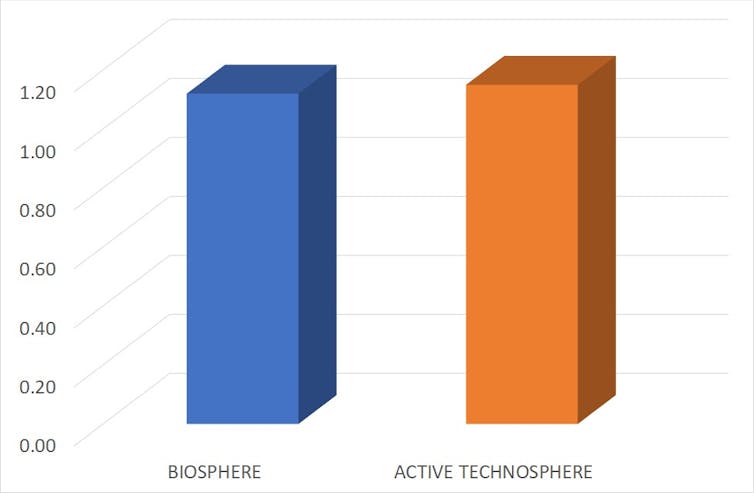 The relative weights of the active technosphere and biosphere. The active technosphere includes materials that are currently in use by human activities. The biosphere includes all living things.
The relative weights of the active technosphere and biosphere. The active technosphere includes materials that are currently in use by human activities. The biosphere includes all living things. Global movement of material: average annual natural sediment transport (blue), the total mass of things transported by humans in 1994 (purple) and in 2015 (orange).
Global movement of material: average annual natural sediment transport (blue), the total mass of things transported by humans in 1994 (purple) and in 2015 (orange). Shipping capacity growth between 1980 and 2022.
Shipping capacity growth between 1980 and 2022.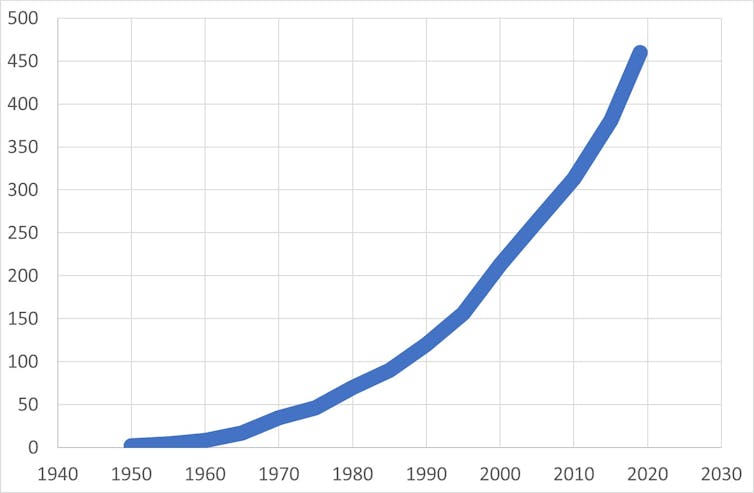 Annual plastic production.
Annual plastic production.![]()








